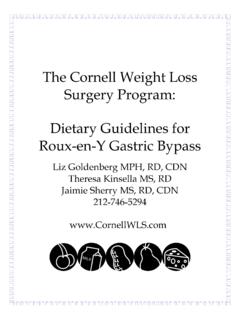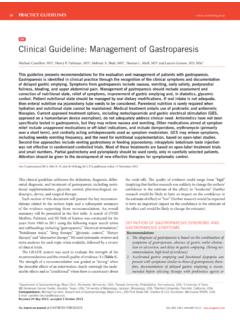Transcription of Vitamin D Deficiency - Royal National Hospital for ...
1 Vitamin D is a fat-soluble Vitamin that is produced endogenously when ultraviolet rays from sunlight trigger Vitamin D synthesis in the skin. Season, latitude, time of day, cloud cover, smog, skin melanin content, and sunscreen are among the factors that affect UV radiation exposure and Vitamin D synthesis. Vitamin D can be formed from exposure to sunlight during the spring, summer, and autumn months even in the far north latitudes. Approximately 5 30 minutes of sun exposure between 10 AM and 3 PM at least twice a week to the face, arms, legs, or back without sunscreen usually leads to sufficient Vitamin D synthesis. Individuals with limited sun exposure may need to take a supplement to achieve recommended levels of intake.
2 Vitamin can also be obtained through dietary sources although very few foods in nature contain Vitamin D. The flesh of fatty fish (such as salmon, tuna, and mackerel) and fish liver oils are among the best sources. Small amounts of Vitamin D are found in beef liver, cheese, and egg yolks. Other foodstuffs such as margarines and baby foods are often fortified with Vitamin D. Vitamin D promotes calcium absorption in the gut and maintains adequate serum calcium and phosphate concentrations to enable normal mineralization of bone. Vitamin D sufficiency prevents rickets in children and osteomalacia in adults. Together with calcium, Vitamin D also helps protect older adults from falls and fractures.
3 Serum concentration of 25-hydroxyvitamin D is the best indicator of Vitamin D status. It reflects Vitamin D produced cutaneously and that obtained from food and supplements. Vitamin D Deficiency can occur when: usual intake is lower than recommended levels over time. exposure to sunlight is limited. the kidneys cannot convert 25-hydroxyvitamin D to its active form. absorption of Vitamin D from the digestive tract is inadequate. Groups at risk of Vitamin D Deficiency include: breastfed infants older adults people with limited sun exposure people with dark skin people with fat malabsorption or other malabsorption disorders people who are obese or who have undergone gastric bypass surgery Vitamin D Deficiency Vitamin D Deficiency can also occur in people taking certain medicines - examples include: anticonvulsants, barbiturates and some anti-viral medicines.
4 A growing body of research suggests that Vitamin D Deficiency can be associated with a wide range of adverse health outcomes including: type 1 and type 2 diabetes, hypertension glucose intolerance multiple sclerosis increased mortality However, most evidence for these roles comes from in vitro, animal, and epidemiological studies. There is no consensus on the optimal level of 25-hydroxyvitamin D, and this is why many laboratories report varying normal values. Scientific evidence indicates that calcium and Vitamin D play key roles in bone health and that targeting serum values of >75 nmol/L in older adults may be beneficial in this regard.
5 However, the benefits of serum concentrations of 25-hydroxyvitamin D higher than 50 nmol/l on endpoints other than bone health have not been documented by randomized trials. Reference values from the Royal United Hospital (Bath) Laboratory have recently been changed to the following: Interpretation of total 25-hydroxyvitamin D (D2+D3) result: <25 nmol/L: Severe Vitamin D Deficiency Vitamin D replacement is required. 25-50 nmol/L: Vitamin D insufficiency. Advise on safe sun exposure and diet. Supplementation may be indicated. >50 nmol/L: Adequate Vitamin D concentration. There remains uncertainty about the systemic benefits of higher intakes and blood levels.
6 Defining an optimal 25-hydroxyvitamin D level is likely to depend on the health outcome in question. Controlled clinical trials with defined end-points are required to assess the true value of increasing targets for 25-hydroxyvitamin D levels. For guidance on how to treat Vitamin D Deficiency please follow the web link to the BCAP guidelines: References: Bischoff-Ferrari et al. (2004). Positive association between 25-hydroxy Vitamin D levels and bone mineral density: a population-based study of younger and older adults. Am J Med, 116(9), 634-9. Bischoff-Ferrari et al. (2005). Fracture prevention with Vitamin D supplementation: a meta-analysis of randomized controlled trials.
7 JAMA, 293(18), 2257-64. Chiu KC et al. (2004). Hypovitaminosis D is associated with insulin resistance and beta cell dysfunction. Am J Clin Nutr, 79(5), 820-5. Holick MF (2007). Vitamin D Deficiency . N Engl J Med, 357(3), 266-81. Hypponen E et al. (2001). Intake of Vitamin D and risk of type 1 diabetes: a birth-cohort study. Lancet, 358(9292), 1500-3. Krause R et al. (1998). Ultraviolet B and blood pressure. Lancet, 352(9129), 709-10. Marks E, Mishra V (2011). The wider health considerations of calcium and Vitamin D therapy. Osteoporosis Bulletin, April, 1-5. Merlino LA et al. (2004). Vitamin D intake is inversely associated with rheumatoid arthritis: results from the Iowa Women s Health Study.
8 Arthritis Rheum, 50(1), 72-7. Munger KL et al. (2006). Serum 25-hydroxyvitamin D levels and risk of multiple sclerosis. JAMA, 296(23), 2832-8. National Heart Forum (2010). Consensus Vitamin D position statement. Available at: Office of Dietary Supplements, National Institutes of Health (2011). Dietary Supplement Fact Sheet: Vitamin D. Available at: Pearce SHS, Cheetham T (2010). Diagnosis and management of Vitamin D Deficiency . BMJ, 340, 142-7. Pittas AG et al. (2006). Vitamin D and calcium intake in relation to type 2 diabetes in women. Diabetes Care, 29(3), 650-6. Scientific Advisory Committee on Nutrition (2007). Update on Vitamin D.
9 Available at: Thacher TD, Clarke BL (2011). Vitamin D Insufficiency. Mayo Clin Proc, 86(1), 50 60.














